Ten reasons why the arguments against increasing tax are wrong
There are many arguments put forward as to why increasing tax is bad for Australia and its economy. It is also argued that the stage 3 tax cuts due to start in 2024 will be good for the economy. Here are ten reasons why these are wrong.
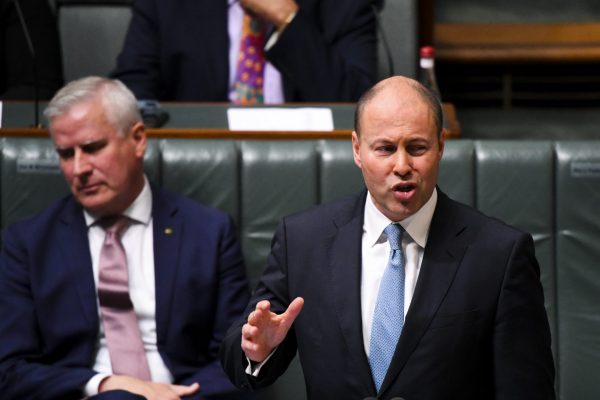
1 // Taxation is not a ‘wet blanket’ on the economy, in fact, research shows it is the opposite
It is often argued that tax represents a burden on the economy. But when we look at economies from around the world, we see that those with higher levels of taxation (tax to GDP ratios) are more likely to have stronger economies than those with low levels of taxation.
For example, Australia Institute research shows higher average income (GDP per person) is more likely to occur in countries with higher levels of taxation.
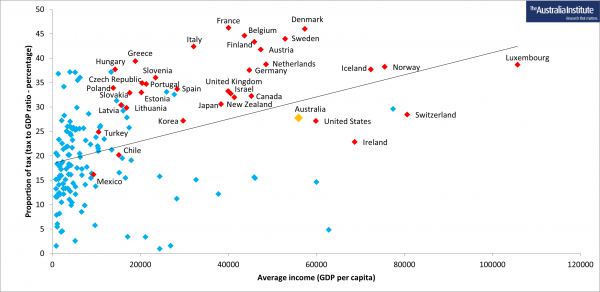
2 // FACT: lower taxes on high income earners do not encourage them to work harder
It is argued that inequality increases economic growth because it is associated with reward for effort. But numerous studies including by the IMF have shown that economies with lower inequality grow faster than economies with higher inequality.
The tax system is one of the best tools we have for fighting inequality as taxation revenue mainly comes from high income earners. But the stage 3 tax cuts threaten this as they mainly go to high income earners. These tax cuts will increase inequality.
The argument that lower taxes on high income earners are needed to make them work harder and longer is also wrong. There is no evidence that any CEO or other highflyer has slackened because taxes are too high. No-one has yet told a boardroom that they would work harder but for the tax rates. But these work incentive effects do happen for low- and middle-income earners who face rising taxes through the withdrawal of benefits like government childcare subsidies. When those people face effective marginal tax rates approaching 100 per cent the incentive effect may occur. But that is not the case for those on salary incomes, earning many times more than the average.
3 // The Stage 3 income tax cuts overwhelmingly benefit the highest income earners
It is argued that the stage 3 tax cuts which will happen in 2024, are fair because the overwhelming majority of taxpayers will face the same 30 per cent marginal tax rate.
Australia Institute analysis shows the stage 3 tax cuts mainly go to high income earners. Over 50 per cent goes to the top 10 per cent of taxpayers. Over 70 per cent goes to the top 20 per cent of taxpayers. The bottom 20 per cent of taxpayers get none of the tax cut.

Someone on the fulltime minimum wage ($39,000 per year) will get nothing form the tax cut. Someone on $200,000 will get over $9,000 a year (or about $350 per fortnight) from the tax cut.
4 // After stage 3 tax cuts, Australia’s income tax will be significantly less progressive
While the income tax system will still be progressive, the stage 3 tax cuts will make them less progressive. A progressive tax system is one where higher income earners pay a higher proportion of tax.
The graph below shows the current tax rates and the tax rates in 2024 when the stage 3 tax cuts some in. It shows that the stage 3 tax cuts make the income tax system less progressive by flattening the tax rates.
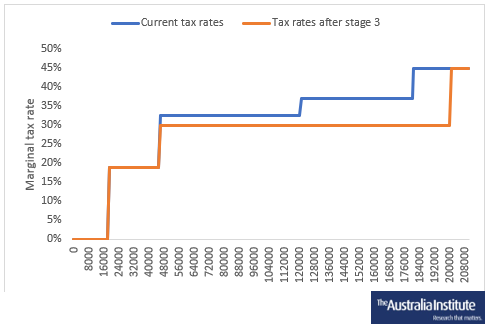
These tax cuts will mean that someone on $45,000 per year will face the same marginal tax rate as someone with just under $200,000 per year. These are wildly different incomes. Someone on $45,000 per year is in the bottom third of taxpayers. Someone on $200,000 is in the top four per cent of taxpayers.
After the stage 3 tax cuts come into effect, high income taxpayers will pay a smaller proportion of the total tax take and low-income taxpayers will pay a higher proportion of the total tax take.
Flattening the income tax scales is the same as reducing how progressive it is.
This flattening of the tax scales has come after the top marginal tax rate has been lifted considerably in the last two decades. After the introduction of the GST (in the year 2000) the top marginal tax rate was $60,000. Eight years later in 2008 it had tripled to $180,000.
In the year 2000, 13.3 per cent of taxpayers paid the top marginal rate. Today the top bracket is $180,000 and just five per cent of taxpayers pay the top marginal rate.
The tax cuts during the mining boom considerably reduced the progressive nature of the income tax system. Stage 3 will weaken it further.
5 // Whether it is on purpose or not, the fact is the tax system benefits men and exacerbates existing gender inequality
While the tax system may not be designed to benefit men, tax cuts including the stage 3 tax cuts reflect and exacerbate existing gender inequality. Men will get twice as much of the tax cut as women. For every dollar of the tax cut that women get, men will get two dollars.
This is because most of the tax cut goes to high income taxpayers and these are more likely to be men. The men alone in the top 20 per cent of taxpayers get more than half of the tax cut, with the women in the top 20 per cent of taxpayers getting 20 percent of the tax cut.
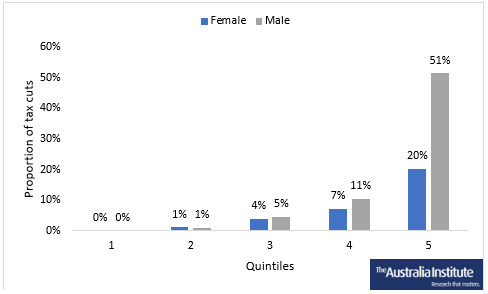
6 // Research shows high income earners have already been overcompensated for so-called ‘bracket creep’
Australia Institute research shows all income levels have already been overcompensated for bracket creep. If we go back to the last tax swap when the Goods and Services Tax (GST) was introduced in 2000. Income tax was cut to compensate for the introduction of the GST. Since then income tax cuts have been larger than the effects of inflation.
If we compare the impacts of inflation with the impact of income tax cuts, we can see that income tax cuts have been larger than inflation for income levels. The overcompensation is largest the higher incomes become.
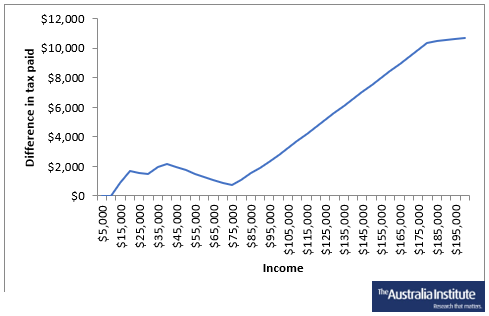
The current stage 3 tax cuts mainly benefit high income earners, who are those who have been most overcompensated. These tax cuts will simply add more overcompensation for those why have already got the most.
7 // FACT: Australia is a low tax country
When compared to other developed (OECD) countries, Australia has the 9th lowest tax to GDP ratio out of 37 nations.
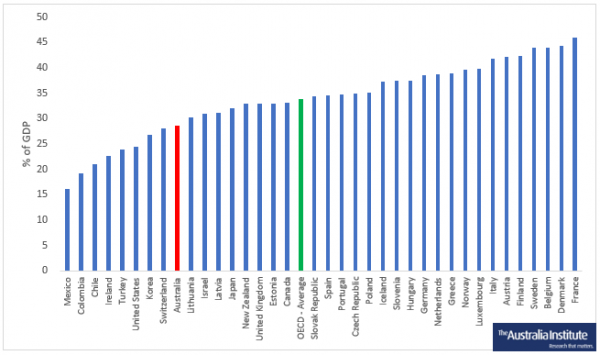
The OECD average is over five percent higher than Australia’s. If Australia collected taxation at the OECD average it would need to collect an additional $101 billion.
8 // In fact, today’s level of Australia’s Federal Government tax is lower than during the Howard Government
Australia’s federal tax to GDP ratio is lower now than when the Howard Government left office. When Howard left office, it was 23.8 per cent, while today (2021-22) it is 20.9 per cent. The average tax to GDP ratio from the introduction of the GST in 2000 to the beginning of the GFC was 24 per cent.
Tax would need to be 2.9 per cent higher or $56.5 billion more if it were same as when Howard left office. Tax would need to be 3.1 per cent higher or $60.4 billion more if it were the same as the average between the introduction of the GST and GFC.
9 // Tax cuts, particularly to high income earners, make poor economic stimulus because they are more likely to save the extra funds rather than putting them back in the economy
Tax cuts, particularly tax cuts that mainly go to high income earners, make poor stimulus.
Stimulus is only useful if it generates additional spending in the economy. If the intended stimulus is saved, then it does not increase spending and is therefore wasted. During a recession people become worried about the future and they attempt to build up a financial buffer by saving money. They do this in case they lose income through less hours or work or losing their job entirely.
The higher the household’s income the more they tend to save. This means a large proportion of any tax cut that go to high income earners will be saved and its stimulatory effect will be much smaller. Tax cuts and money given to low-income households are more likely to be spent as these households spend almost all their income on the essentials of life and have little or no capacity to save.
These means that the stage 3 tax cuts, which mainly go to high income earners are likely to be poor stimulus.
The timing of the stage 3 tax cuts also makes them poor stimulus. They are not legislated to come into effect until 2024. It is very unlikely that the economy will need major stimulus that many years after the recession.
The Government when it legislated the stage 3 tax cuts in 2018 and then again when they increased them in 2019 said that they were affordable because of the expected strong economic growth out to 2024. The Government was arguing that when times were good, we should cut taxes. Since 2019 the economy has collapsed into recession following the coronavirus pandemic. The Government is now effectively arguing that when times are bad, we need the same tax cuts.
10 // Taxation is popular with the general public, who understand that taxes are what we pay for a civilised society
It is commonly believed that taxation is deeply unpopular with the public. But polling by the Australia Institute shows that people have a more sophisticated approach to taxation than is often understood.
Australia Institute research polled a nationally representative sample of 1,000 Australians about their attitudes to tax.[1] It found seven in ten (69 per cent) of Australians agree with Oliver Wendell Holmes’ quote that ‘taxes are what we pay for a civilised society.’ With a majority of Coalition, Labor and Green’s voters agreeing.
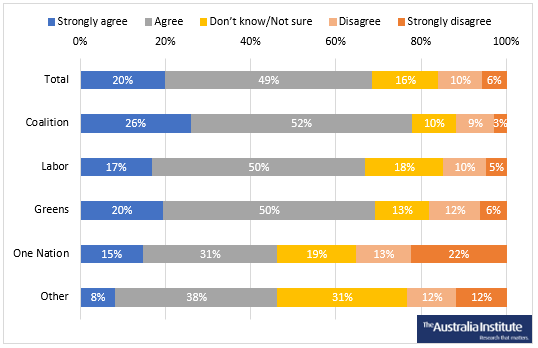
Six in ten agreed with the broader statement that ‘tax is good.’ Again, a majority of Coalition, Labor and Green’s voters agreed.
When respondents were asked about budget priorities, the most popular response was spending on government services like health and education (chosen by 36 per cent of respondents). The second least popular was tax cuts (12 per cent of respondents), the least popular was decreasing the deficit and repaying debt (nine per cent of respondents).
It is clear that taxation is not as unpopular as is commonly understood and the public would rather see more funding of government services rather than tax cuts.
Between the Lines Newsletter
The biggest stories and the best analysis from the team at the Australia Institute, delivered to your inbox every fortnight.
You might also like
5 ways and 63 billion reasons to improve Australia’s tax system
With a federal election just around the corner, new analysis from The Australia Institute reveals 63 billion reasons why our next Parliament should improve the nation’s tax system.
10 reasons why Australia does not need company tax cuts
1/ Giving business billions of dollars in tax cuts means starving schools, hospitals and other services. Giving business billions of dollars in tax cuts means billions of dollars less for services like schools and hospitals. If Australia cut company tax from 30% to 25% this would give business about $20 billion in its first year,
Business groups want the government to overhaul the tax system? Excellent – we have some ideas.
The landslide win by the ALP has seen business groups come out demanding the government listen to their demands despite having provided them no support, and plenty of opposition, over the past 3 years.


